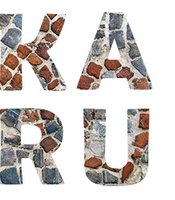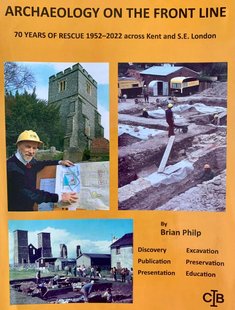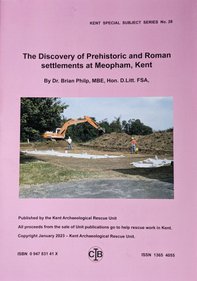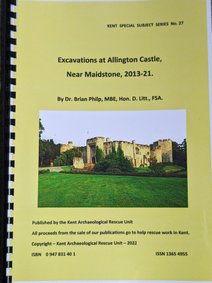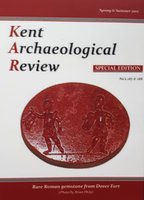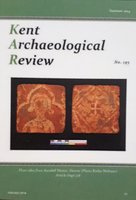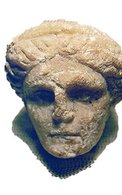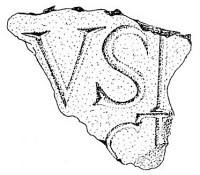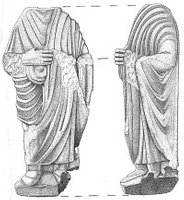Roman Painted House, Dover
Discovery and Excavation
The Roman Painted House, the finest Roman House on show in Britain, was discovered by Kent Archaelogical Rescue Unit. Forty years of excavation across ancient Dover by the Unit have uncovered 50 major structures. The Painted House was the best preserved and is now a major tourist attraction. Built about AD 200 it formed part of a large mansio or official hotel, for travellers crossing the Channel. It stood outside the great naval fort of the Classis Britannica, but in AD 270 it was demolished by the Roman army during the construction of a larger fort.
The long-lost Roman 'Saxon Shore' fort, predicted by Sir Mortimer Wheeler and found by the Kent Unit in 1970, lies buried under modern Dover. A large section of its west wall, together with a major bastion, survive inside the Roman House cover building. These cut through Rooms 3, 4 and 5.
National Awards
After discovery in 1970 the Kent Unit promoted a major tourist-preservation scheme and the House was opened in 1977, on behalf of the Dover Roman Painted House Trust. Over 700,000 visitors have seen the Roman House which is open for 150 days each year. Admission charges and voluntary effort almost cover the running-costs. The Scheme won four national awards, including "The Best Preservation of an Archaeological Site in Britain" (Country Life Award). "Outstanding Tourist Enterprise" (B.T.A. Award) and "Museum of the Year Award". The Unit also won the famous Silver Trowel Award, presented to it by H R H King Charles.
Roman Central Heating
The walls in four rooms survive to a height of 4-6 feet and the hard red concrete floors cover substantially complete central-heating systems. Visitors can see the large arched flues, the various heating channels and the vertical wall-flues that kept the building comfortably warm 1,800 years ago.
Unique Roman Wall Paintings
The burial by the Roman Army resulted in the unique survival of over 400 square feet of Painted plaster, the most extensive ever found north of the Alps. Above a lower dado, of red or green, visitors can still see an architectural scheme of many coloured panels framed by fluted columns. The columns sit on projecting bases above a stage, producing a clear 3-D effect. Parts of 28 panels survive, each with a motif relating to Bacchus, the Roman God of wine.
Notices
Please note that the Roman Painted House has now re-opened. Please see our update below.
NEWS
Dover Roman Painted House - The Gremlins Strike!
All genuine people readily acknowledge how our Kent Unit discovered the Roman House in 1970, saved it from certain destruction, raised the funds for preservation, helped form an umbrella Trust, carried out the whole cover-building and presentation programmes, thus saving at least £200,000. Our efforts won four national awards. Thereafter, for more than 40 years, the Unit team of staff and volunteers managed the whole project without charge. Some 700,000 visitors and many schools enjoyed the site and our tours, mostly five days a week for seventh months each year. Visitors included the Queen Mother, an American astronaut and the Russian Ambassador! In 2013 the Kent Unit was given The Queens Award for Voluntary Service for its brilliant work on the Dover Roman House!
All this good work for Dover was blocked in July, 2023, when the locks were changed by unhelpful trustees whilst the Unit Director, was in hospital. Workshy Gremlins caused months of neglect, inside and outside, with mould forming on many books and boxes. – Predictably, unable to cope, they then surrendered the Lease back to Dover Council although it still had 17 good years to run. It just may reopen at the end of the summer when the Gremlins may “overlook” the decades of excellent work by the Unit and without which the site would have closed many years ago ! Well done Dover!
Dr. Brian Philp, MBE, Hon. D.Litt. FSA. (Director, Kent Archaeological Rescue Unit). Founding trustee of the Dover Roman Painted House Trust.
The Unit has published four major research volumes on its 40 year programme of excavations across central Dover and these have an international circulation. Another volume will be completed in 2024 and the following year a complete plan of Roman Dover will be created, based upon 45 Unit excavations and the numerous copyright plans, sections and photographs.
NEWS
Dover Roman Painted House - The Gremlins Strike!
An Update 24/09/2024
The RPH eventually reopened in September and as predicted the Unit's excellent work over some 50 years carefully ignored.
All our 26 major information panels destroyed, all the Unit's books, equipment, tools, archives and artefacts taken without consent and either discarded or with-held by Dover Council.
- The panel with Unit's four national awards - Gone!
- The plaques dedicated to team members - Gone!
- The panel of Queen Mum's visit showing two founding trustees - Gone!
- All four major volumes on our Dover excavations ignored.
Brief note relegated to the basement states our excavations were just seven years (1970-7) instead of over 40 years of non-stop work, with vital publication still in progress.
All done under the direction of the DDC museum curator! - A very poor response for a lifetime's work.
Thank you Dover!
Dr. Brian Philp, MBE, Hon. D.Litt. FSA. (Director, Kent Archaeological Rescue Unit). Founding trustee of the Dover Roman Painted House Trust.
PUBLICATIONS
Dr. Philp’s book, ‘Archaeology on the front line - 70 years of rescue 1952 - 2022 across Kent and S.E. London’ is out now!
A fascinating record of his 70 year career, the book covers sites across Kent and S.E. London.
The Latest KARU Publications By Dr. Brian Philp MBE, Hon. D. Litt., FSA are now available for purchase via our
- No. 27 - Excavations at Allington Castle Near Maidstone, 2013 - 21
- No. 28 - The Discovery of Prehistoric and Roman settlements at Meopham, Kent
Visit our Publications Page to find out how to purchase your copy!
All proceeds go towards further rescue work in Kent.
Kent Archaeological Review
Although the Council for Kentish Archaeology (CKA) has ceased to function the Kent Unit holds most of the back numbers of the Kent Archaeological Review and these can be purchased from KARU (at £1 a copy, plus 20% postage), only by post.
Please send any requests and enclose a cheque made payable to Kent Archaeological Rescue Unit to:
18 Highfield Avenue, Orpington BR6 6LF
When ordering, please give your name, address, issue numbers and quantity of copies.
Opening Times:
Please check back for 2025 opening times!
Address:
Dover Roman Painted House Trust
25 New Street
Dover
Kent
CT17 9AJ
Admission:
To be confirmed
Important Notice:
This major tourist attraction is managed and staffed entirely by volunteers, who have worked here for the past 39 years. There are no paid staff. Occasionally, through illness or other problems, some volunteers may not be available as planned and (rarely) days may be missed. If your visit involves a long journey, you might consider phoning the Painted House in advance to ensure that it's open when you arrive – 01304 203279.
Activities at the Roman Painted House
Please note that activities may be limited until further notice.
- Graphic displays of the excavations and RPH
- The Touch Table with a selection of Roman finds from the excavation for handling
- Replica Roman everyday objects, including pots, jewellery, lamps and writing tablets
- Activities for children - Roman games to play, mosaic making, dressing up as Romans and digging for finds in the excavation tray
- Roman soldier 'rubbings'
- Gift shop selling guide books, postcards, souvenirs and books on local archaeology
Special Exhibit of Finds
Following the publication of the Roman shore-fort at Dover in 2012 (KARU Volume 11 of Kent Monograph Series) a special display of some of the outstanding Roman artefacts discovered during the rescue excavations are now on display.
It is well worth making a visit to the Roman Painted House at Dover just to see these and several other amazing pieces in this special display!
(You can purchase a copy of the Dover shore-fort volume by visiting our publications page).
On display we have this fine sculpted marble head of a woman. It has been suggested she could be the Empress Sabina, Consort of the Emperor Hadrian or of a woman who copied Sabina's hairstyle. It might have been set in an alcove in a wall and used as a shrine during the Classis Britannica period.
Part of a well-cut inscription is also on display. The fragment consists of just parts of two lines with faint traces of red paint in the letters. The upper three letters (VSI) is unusual and the lower sT suggests a Classis Britannica link. It is suggested this piece was part of a monumental dedication inscription.
This headless sculpture ia a fine example of a statue representing a third life-size Roman wearing a full toga.
Information for Teachers: School Visits to the Roman Painted House
Please note that we are unable to take school bookings at present. We are keeping a close eye on government guidelines. Please keep checking our website for updates.
Managed by the Kent Archaeological Rescue Unit staff
Your school is cordially invited to visit this major Roman site at Dover and to take part in its special Roman Life Activity Workshops.
Bookings and Other Details
- Workshop sessions: Tuesdays and Wednesdays, 10am or 12.45pm
- £3.00 per child; teachers and helpers free (maximum 5 per class)
- Teachers and helpers are asked to help with supervision
- Each session lasts about two hours
Telephone 01304 203279 (9am - 5pm: Tuesdays and Wednesdays in October - December, and March (from the 18th March); Tuesdays to Fridays in April to September) -- or Write to Roman Painted House, 25 New Street, Dover, Kent CT17 9AJ
- The Roman House is close to Dover Town Centre and 600 metres from Dover Priory Station
- There is a forecourt for limited car parking and off loading coaches
- There are indoor toilets
Risk Assessment
Download the Risk Assessment notice
Roman Life Acitivity Workshops
An introductory talk by an archaeologist on the exciting discovery and excavation of the Roman forts and the Roman Painted House. To illustrate one aspect of life in the Roman Dover, three children can be dressed as Romans -- as a Roman lady, a Roman senator and a Roman slave boy.
A guided talk on the key elements of the Roman House -- its in situ wall paintings relating to the god Bacchus, its well preserved underfloor central heating system (hypocaust), its construction by the Roman navy in AD 200 and partial demolition and burial later (AD 270) by the Roman army when it built its new fort.
Other activities include:
- Handling, drawing and labelling Roman artefacts: each child has a tray of 'finds', including pottery, oyster shells and building materials from the Dover excavations.
- 'Brass-rubbings' of 14 centimetre high Roman figures to take back to school. These include various ranks of Roman soldiers, Julius Caesar, a Roman marine, the Dover lighthouse (pharos) and a Roman merchant ship.
- Mosaic making: each child has a tray of multi-coloured 'tesserae' and Roman patterns to follow.
- Sample worksheets can be provided for schools to copy, if these are preferred to one of the above activities.
- Touch table of Roman artefacts combined with a visit to the sales desk. Items, mostly under £2.00, include a guide book, postcards, colouring book on Dover and souvenirs.
